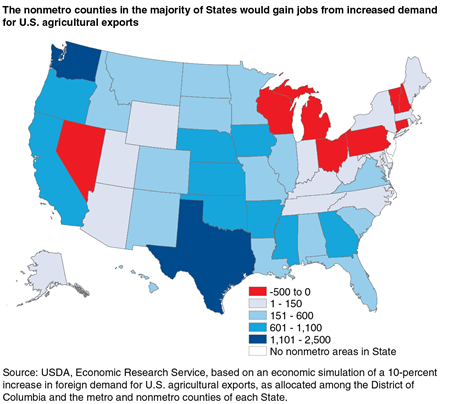Increased Demand for U.S. Agricultural Exports Would Likely Lead to More U.S. Jobs

U.S. agricultural exports support about 1.1 million full-time, civilian jobs, according to 2017 ERS estimates based on 2015 data. How would U.S. employment be affected if the demand for these exports increased even further?
To answer this question, ERS researchers used a computational model of the U.S. economy to explore the possible effects of a hypothetical 10-percent increase in foreign demand for U.S. agricultural products. They found that such an increase would result in a 6.7-percent rise in the volume of U.S. agricultural exports. The growth in export volume is smaller than the increase in export demand because the demand stimulus is partially offset by an increase in export prices. Another finding was that total U.S. employment (agricultural and nonagricultural) would increase by about 41,500 jobs, above and beyond the approximately 1.1 million jobs currently supported by U.S. agricultural exports.
By apportioning the national results to the groups of metro and nonmetro counties within each State, the researchers were able to conduct a regional analysis of the export-employment relationship. For total nonmetro employment, 39 of the 47 States with nonmetro counties experienced nonmetro job growth, with 26 States seeing nonmetro job growth above 0.05 percent, compared with the model’s base values. In absolute terms, 4 States see a net increase in nonmetro employment of 1,000 jobs or more: Washington State and Texas (each with a net increase in excess of 2,000 jobs), and Iowa and Georgia (each with a net increase in excess of 1,000 jobs). For total metro employment, 28 States plus the District of Columbia see an increase in metro employment from greater agricultural exports, with metro jobs growing in excess of 0.05 percent in 13 States.
The current level of employment in the agri-food sector (agricultural production plus food and beverage manufacturing) was a key factor in explaining the size of the simulation’s regional employment effects. There were 16 nonmetro regions where the agri-food sector accounted for more than 10 percent of total employment, ranging from nonmetro Iowa (11 percent) to Washington State (26 percent). As a group, these regions accounted for just 5 percent of U.S. employment but 32 percent of the total employment gain for the United States resulting from the simulated increase in agricultural exports.
The Potential Effects of Increased Demand for U.S. Agricultural Exports on Metro and Nonmetro Employment, by Steven Zahniser, Thomas Hertz, Peter B. Dixon, and Maureen T. Rimmer, ERS, April 2017


